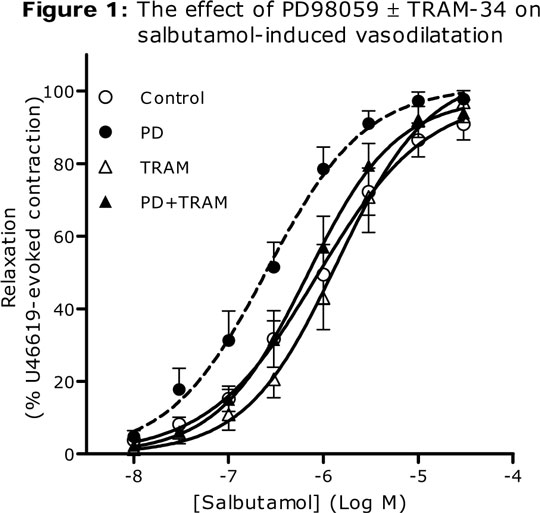Inhibition of extracellular signal-regulated kinase (ERK) enhances β-adrenoceptor-mediated vasodilatation in porcine isolated coronary artery: role of potassium channels We have previously shown that inhibition of ERK in porcine blood vessels enhances relaxation responses to β-adrenoceptor (β-AR) agonists (Uhiara et al., 2009). In some vessels, β-AR-induced relaxation of smooth muscle involves activation of K+ channels (Huang and Kwok, 1997) and our previous studies have suggested that the increased activation of K+ channels is involved in the ERK-mediated regulation of the relaxation. In this study, we have used selective channel blockers to determine which K+ channels are involved. Ring segments of porcine coronary artery were prepared as previously described (Uhiara et al., 2009). Segments were pre-incubated for 45 min with either the upstream inhibitor of ERK PD98059 (50 μM) or a selective K+ channel blocker (either glibenclamide (10μM), iberiotoxin (100 nM) or TRAM-34 (10 μM)), or a combination of PD98059 and each blocker. Tissues were then pre-contracted with the thromboxane mimetic U46619 to 70-80% of the 60 mM KCl response, before they were relaxed with cumulative concentrations of the β2-AR agonist salbutamol. Effects of the drugs were assessed using one-way ANOVA followed by a Tukey post-hoc test, with data from at least five separate animals of either sex.

Application of salbutamol (10 nM – 30 μM) to precontracted vessel segments induced a concentration-dependent vasodilatation. PD98059 alone shifted the concentration response curves to the left. None of the potassium channel blockers altered the salbutamol response. However, incubation with TRAM-34, but not glibenclamide or iberiotoxin, prevented the left-shift to PD98059 (pEC50 values: control = 6.1 ± 0.2, PD98059 = 6.7 ± 0.1, PD98059+TRAM-34 = 6.1 ± 0.1; P<0.05; Figure 1). As we have previously observed, the vasodilatation response to β2-AR activation in porcine precontracted coronary artery segments was augmented by PD98059, an inhibitor of ERK activation. This phenomenon was prevented by co-incubation of PD98059 and TRAM-34, a potent inhibitor of the intermediate-conductance Ca2+-activated K+ channel (Wulff et al., 2000). Inhibitors of high-conductance Ca2+-activated K+ channels (iberiotoxin) and ATP-sensitive K+ channels (glibenclamide) did not alter the PD98059-induced enhancement of the vasodilatation response. The data suggest that the enhanced β2-AR-mediated vasodilatation may be due to an increased activity of the intermediate-conductance Ca2+-activated K+ channel in this tissue.
Hwang and Kwok (1997) J Cardiovasc Pharm 29, 515-519. |
|

